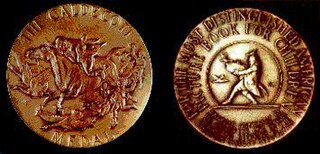
The Randolph Caldecott Medal, frequently shortened to just the Caldecott, annually recognizes the preceding year's "most distinguished American picture book for children". It is awarded to the illustrator by the Association for Library Service to Children (ALSC), a division of the American Library Association (ALA). The Caldecott and Newbery Medals are considered the most prestigious American children's book awards. Besides the Caldecott Medal, the committee awards a variable number of citations to runners-up they deem worthy, called the Caldecott Honor or Caldecott Honor Books.
Trina Schart Hyman was an American illustrator of children's books. She illustrated over 150 books, including fairy tales and Arthurian legends. She won the 1985 Caldecott Medal for U.S. picture book illustration, recognizing Saint George and the Dragon, retold by Margaret Hodges.

Many Moons is an American children's picture book written by James Thurber and illustrated by Louis Slobodkin. It was published by Harcourt, Brace & Company in 1943 and won the Caldecott Medal in 1944. The book centers around a young girl, Princess Lenore, who becomes ill, and only one thing will make her better: the Moon. The book was Thurber's first picture book.
Barbara Cooney was an American writer and illustrator of 110 children's books, published for over sixty years. She received two Caldecott Medals for her work on Chanticleer and the Fox (1958) and Ox-Cart Man (1979), and a National Book Award for Miss Rumphius (1982). Her books have been translated into ten languages.
Molly Garrett Bang is an American illustrator. For her illustration of children's books she has been a runner-up for the American Caldecott Medal three times and for the British Greenaway Medal once. Announced June 2015, her 1996 picture book Goose is the 2016 Phoenix Picture Book Award winner – that is, named by the Children's Literature Association the best English-language children's picture book that did not win a major award when it was published twenty years earlier.
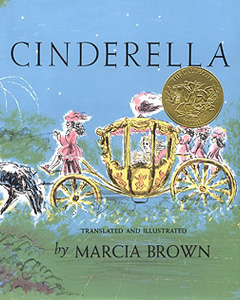
Cinderella, or the Little Glass Slipper is a book adapted and illustrated by Marcia Brown. Released by Charles Scribner's Sons, the book is a retelling of the story of Cinderella as written by Charles Perrault, and was the recipient of the Caldecott Medal for illustration in 1955. The book takes place in France, in a palace similar to other Cinderella stories.

The Lion & the Mouse is a 2009 nearly wordless picture book illustrated by Jerry Pinkney. This book, published by Little, Brown and Company, tells Aesop's fable of The Lion and the Mouse. In the story, a mouse's life is a spared by a lion. Later, after the lion is trapped, the mouse is able to set the lion free. Adapting the fable, with the moral that the weak can help the strong, as a wordless picture book was seen as a successful way of overcoming the brief plot generally found in the source stories. While it was Pinkney's first wordless picture book, it was not the first time he had told the story, having previously included it in his Aesop's Fables, published in 2000. Pinkney, who had received five Caldecott Honors, became the first African American to win the Caldecott Medal for his illustrations in this book. His illustrations were generally praised for their realism and sense of place. The cover illustrations, featuring the title characters but no text, drew particular praise.

Grace Lin is a Taiwanese-American children's writer and illustrator. She is a Newbery, Geisel, and Caldecott honoree, known for contributing to and advocating for Asian American representation and diversity in children’s literature. She has published more than 25 books, all of which are written for young and middle-grade audiences. Much of her work features young Asian and Asian American characters in both everyday and fantastical settings.
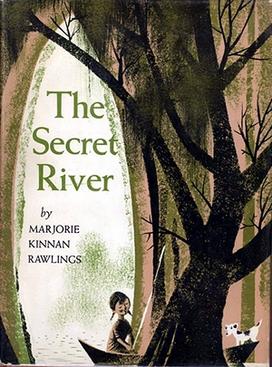
The Secret River is a children's fantasy novel by Marjorie Kinnan Rawlings, author of The Yearling. Published in 1955, The Secret River received a Newbery Honor Award. The first edition, illustrated by Caldecott Medal winner Leonard Weisgard, was issued after Rawlings' death. The book was revised and reissued in 2009 with illustrations by Caldecott Medalists Leo and Diane Dillon. The new edition received an international children's book design award in 2012. The Secret River is the only book Rawlings wrote specifically for children. The story of young Calpurnia, who goes on a quest to find a magical river and catch fish for her starving family and friends, it has two themes common in Rawlings' writing, the magic of childhood and the struggle of people to survive in a harsh environment.

Finding Winnie: The True Story of the World's Most Famous Bear is a 2015 children's book written by Canadian author Lindsay Mattick and illustrated by Sophie Blackall. The non-fiction book is framed as a story Mattick is telling to her son. Her great-grandfather, Harry Colebourn bought a bear on his way to fight in World War I, donating the bear to a zoo where it became the inspiration for the character of Winnie-the-Pooh. Finding Winnie was thoroughly researched by both Blackall and Mattick. The book's writing and illustrations were well reviewed and it won the 2016 Caldecott Medal.

Wolf in the Snow is a 2017 wordless picture book by Matthew Cordell. The book was favorably received by critics and won the 2018 Caldecott Medal. The story has drawn comparisons to fairy tales like Little Red Riding Hood. The nearly wordless book tells the story of a girl and wolf who each get lost in the snowstorm. Cordell used distinctive illustration techniques for the girl and the wolf.

Big Cat, Little Cat is a 2017 children's picture book written by Elisha Cooper. It was published by Roaring Brook Press, a subsidiary of Macmillan Books. In the story, a large, white cat welcomes a new black cat into a family. The white cat then dies, and the cycle begins anew when the family adopts a new kitten. Cooper was inspired to write the story after his family experienced a similar situation. Critics praised his illustrations, for their ability to help further the story's messages and themes. These monochromatic illustrations were different than the style Cooper normally employed when illustrating a book. The book was well-reviewed, and received a 2018 Caldecott Honor.
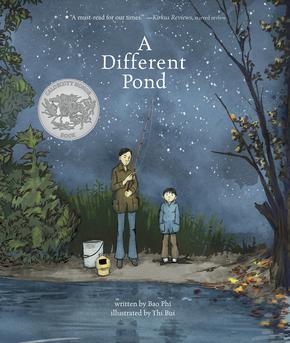
A Different Pond is a 2017 children's picture book by Bao Phi, illustrated by Thi Bui. The book tells the story of a boy and his father going fishing. Phi created the book because of his desire to have books about people like himself to read to his daughter. Bui's detailed illustrations allowed Phi to remove elements of the prose. Bui, who had never illustrated a traditional picture book before, won praise for her use of colors and was recognized with a 2018 Caldecott Honor. The book received positive reviews and appeared on best of 2017 book lists.
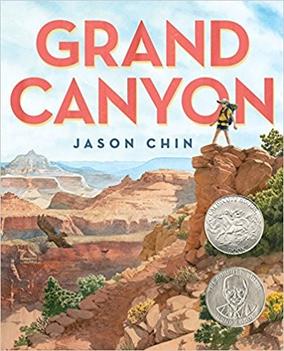
Grand Canyon by Jason Chin is a 2017 children's picture book. The book tells about the plants, animals and habitats of the Grand Canyon, both now and in the past, using the premise of a hiking trip there. The inspiration for the book was a trip in high school; Chin had originally conceived of a Grand Canyon origin story. The book marked the first time Chin used die cuts, in addition to his normal use of pen and ink, watercolors, and gouache. The book was awarded a 2018 Caldecott Honor for its illustrations and a 2018 Sibert Honor for its informative text. Grand Canyon is one of only a few non-fiction books that are not biographies to be recognized by the Caldecott.

The Rough Patch is a 2018 picture book by Brian Lies. An idea of Lies' for more than ten years, when it was published it was well received and was named a 2019 Caldecott Honor book. The story tells of a fox named Evan whose dog dies. Evan then experiences various emotions while grieving before adopting a new dog at the end of the book. The book was praised for Lies' mixed media illustrations, in particular the way he used light and shadow.
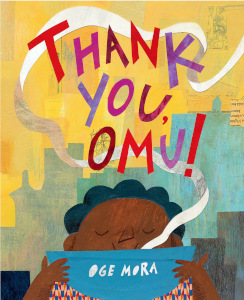
Thank You, Omu! is a 2018 picture book written and illustrated by Oge Mora. The story is about Omu, who cooks a stew and shares it with her neighbors; they show their gratitude by bringing her food. The book started as an assignment for a class of Mora's at the Rhode Island School of Design, where it was seen by an editor from Little, Brown. Thank You, Omu was well reviewed and a recipient of the 2019 Caldecott Honor for its illustrations. The book's mixed media drew praise for their detailed depictions of characters and locations.

Alma and How She Got Her Name is a 2018 children's picture book by Juana Martinez-Neal. Alma, whose full name is Alma Sofia Esperanza José Pura Candela, thinks she has too many names and so she asks her dad about them. He explains the various people she was named to honor. The book was spurred by Martinez-Neal's Peruvian immigrant experience and the birth of her children. The book was well reviewed and received a 2019 Caldecott Honor for its illustrations. The graphite and colored pencil illustrations feature only a few colors, including blue and pink. Martinez-Neal hoped to evoke the feel of a photo album, in keeping with the book's theme of family.

LeUyen Pham is a children's book illustrator and author. She has illustrated and written more than 120 books. In 2020, she won a Caldecott Honor for her illustrations in the book Bear Came Along.

Bear Came Along is a 2019 picture book by Richard T. Morris and illustrated by LeUyen Pham. It tells the story of a group of animals on a river adventure. Published on June 1, 2019, Bear Came Along was based on memories Morris had of going to overnight camp for the first time. The watercolors, ink, and gouache illustrations Pham created were special for her. Critics wrote about her ability to juggle several different tones through the pictures. These illustrations were also generally seen as complementing the book's theme of being connected to others. The book was generally well reviewed and received a 2020 Caldecott Honor.

Going Down Home with Daddy is a 2019 picture book written by Kelly Starling Lyons and illustrated by Daniel Minter. It tells the story of a young boy who attends a large family reunion at his great-grandmother's house and struggles to prepare a contribution to the family celebration. Inspired by Lyons's visit to a family gathering in rural Georgia, the book was published by Peachtree Publishing on April 1, 2019. The acrylic illustrations incorporate Adinkra symbols representing various concepts in Ghanaian culture. Critics praised the book's themes of family culture and heritage as well as Minter's illustrations, for which it received a Caldecott Honor in 2020. It also received the 2019 Lupine Award in the Picture Book category.

















